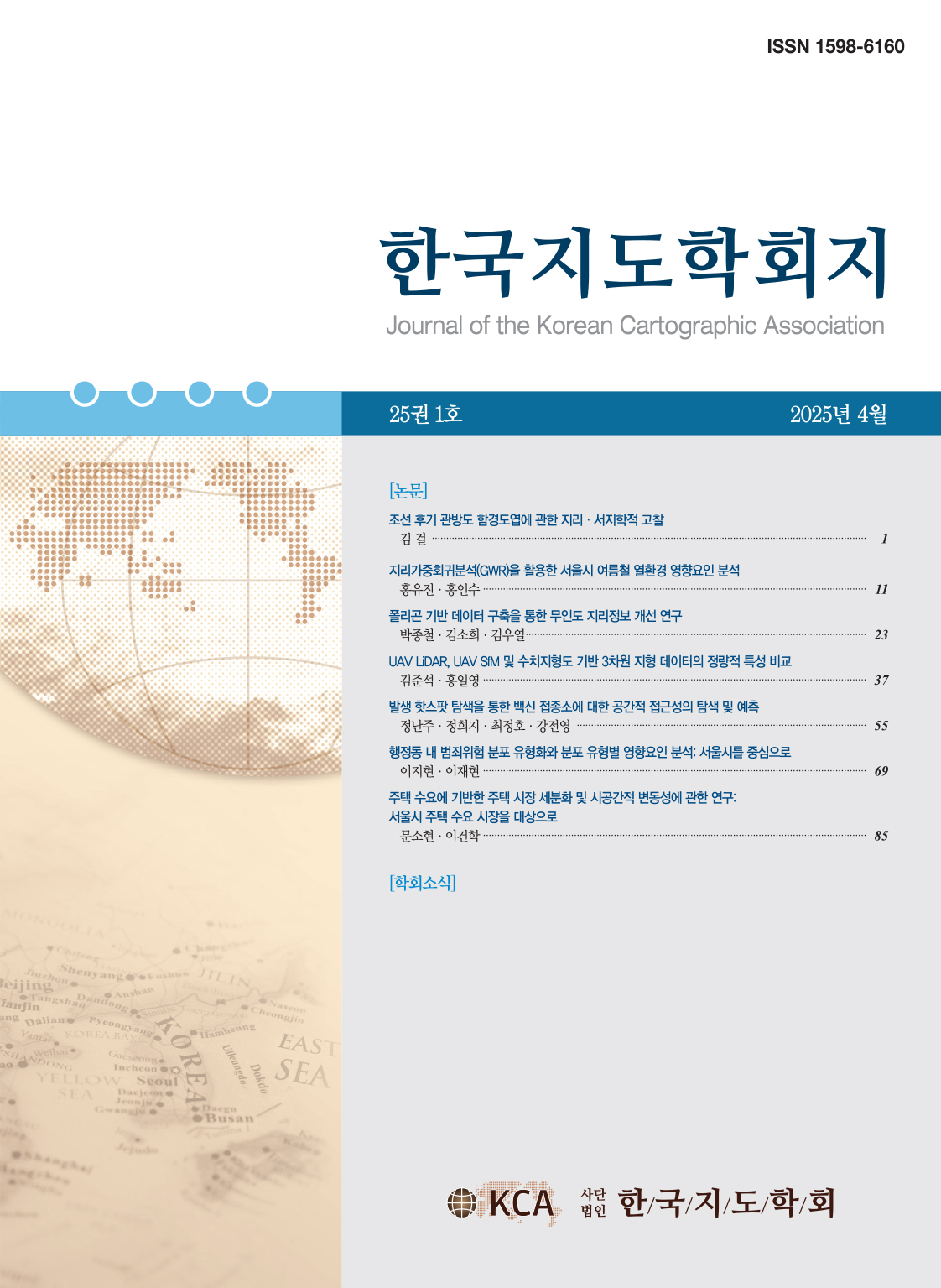Research Article
Abstract
References
Information
The spread of COVID-19 and the implementation of various preventive measures, such as social distancing, have led to considerable changes in the distribution of populations in urban areas. However, these changes could vary depending on the demographic composition, environmental features, and socioeconomic characteristics of the areas. In this regard, this study examines the levels of segregation in two Chinese neighbourhoods in Seoul, Garibong-dong and Daerim 2-dong. We evaluate daily changes in the Korean and Chinese populations between November, 2019 and October, 2020, and the result demonstrates that the two Chinese communities are affected differently. It suggests that the impact of COVID-19 is not spatially homogeneous in urban areas, not even within the so-called ethnic communities.
신종코로나바이러스감염증(코로나19)의 확산과 거리두기와 같은 방역 정책의 시행은 도심의 생활인구 분포에 상당한 변화를 가져왔다. 그러나 이러한 변화의 양상은 서울시 안에서도 상권의 유형과 주거인구의 특성에 따라 다르게 나타나며, 외국인 밀집지역 간에도 해당 지역에 주로 거주하는 외국인의 체류 기간과 이주 목적 등에 따라 상당한 차이를 보일 수 있다. 본 연구에서는 서울의 대표적인 중국인 밀집지역인 가리봉동과 대림2동을 사례로, 두 지역에서 코로나19 확산 이후 내외국인의 분리 수준이 어떻게 변화했는지 살펴볼 것이다. 내외국인의 공간적 분포는 서울 생활인구 데이터를 통해 확인하였으며, 분리 수준의 측정에는 커널 밀도 기반의 측도인 S를 사용하였다. 본 연구 결과는 코로나19가 중국인 밀집지역에 미친 영향을 실증적으로 파악하고, 지역의 특성에 따라 이러한 영향이 차별적으로 나타날 수 있음을 밝혔다는 점에서 의미가 있다.
- 김윤경・문태헌・허선영・정윤영, 2014, "외국인 밀집지역의 공간적 분포와 영향요인 분석," 주거환경, 12(2), 1-15.
- 김혜진・이자원, 2018, "수도권 외국인 이주자의 거주지 분포," 예술인문사회융합멀티미디어논문지, 8(1), 527-538.
- 도경선, 1994, "서울市의 社會階層別 居住地分化에 關한 硏究," 지리학논총, 23, 25-48. 10.3733/ca.v048n01p23
- 박윤환, 2010, "수도권 지역 외국인들의 거주지 분리에 대한 연구," 행정논총, 48(4), 429-453.
- 박윤환・임현철, 2015, "외국인 주민의 거주지 분리에 대한 공간적 패턴," 입법과 정책, 7(2), 125-148.
- 박재영・강진구, 2016, "서울시 조선족 밀집지역과 거주 공간 확대에 대한 연구," 탐라문화, 53, 255-290.
- 박찬영, 2020, "서울의 외국인 밀집지역 유형화와 도시・ 건축 환경에 관한 연구," 서울대학교 박사학위논문.
- 방성훈・김수현, 2012, "한국계 중국인 밀집주거지의 분화에 관한 연구," 한국사회정책, 19(2), 39-68. 10.17000/kspr.19.2.201206.39
- 서울특별시 정보기획관・KT BigData 사업지원단, 2018, 「서울 생활인구추계 매뉴얼」, 서울시.
- 서지수, 2012, "서울 대림동의 조선족 '통로 (Portal)'로서 장소성 형성," 지리학논총.
- 손승호, 2008, "서울시 외국인 이주자의 분포 변화와 주거지분화," 한국도시지리학회지, 11(1), 19-30.
- 윤진희・권오규・마강래, 2014, "서울시 중국국적외국인의 주거지 분포 변화에 관한 연구," 한국지역개발학회지, 26(2), 39-54.
- 이석준・김경민, 2014, "서울시 조선족 밀집지 간 특성 분석과 정책적 함의," 서울도시연구, 15(4), 1-16.
- 이용균・이현욱, 2012, "이주자 공간의 지도화와 공간분포의 특성; 국적과 체류유형을 중심으로," 한국지도학회지, 12(2), 59-74.
- 이정현・정수열, 2015, "국내 외국인 집중거주지의 유지 및 발달," 한국지역지리학회지, 21(2), 304-318.
- 임석희・송주연, 2010, "우리나라의 외국인 전문직 이주자 현황과 지리적 분포 특성," 한국지역지리학회지, 16(3), 275-294.
- 지상훈, 2020, "COVID-19로 인한 서울시 생활인구의 변화," 노동리뷰, 81-84.
- 진주혜・성병찬, 2020, "코로나-19에 따른 서울시 생활인구 변화와 동별 반응 차이 분석," 응용통계연구, 33(6), 697-712.
- 최은진・김의준, 2011, "출신국적에 따른 서울시 외국인 이주자의 거주지 분리," 도시행정학보, 24(4), 85-107.
- 하성규・마강래・안아림, 2011, "서울시 외국인 주거지의 공간적 분리패턴에 관한 연구," 서울도시연구, 12(3), 91-105.
- 허정원・장주영, 2020, "코로나19 확산시기 서울시 외국인 밀집지역의 지역특성과 생활인구 변화," 공간과 사회, 73, 99-137.
- 홍성연・오지예・김예린・강수민, 2020, "소득계층별 활동공간의 비교 분석; 커널 밀도 기반의 분리 측정," 대한지리학회지, 55(2), 207-217.
- Allen, J.P. and Turner, E., 1996, Spatial patterns of immigrant assimilation,
The Professional Geographer , 48(2), 140-155. 10.1111/j.0033-0124.1996.00140.x - Duncan, O.D. and Duncan, B., 1955, A methodological analysis of segregation indexes,
American Sociological Review , 20(2), 210-217. 10.2307/2088328 - Hong, S.Y., O'Sullivan, D., and Sadahiro, Y., 2014, Implementing spatial segregation measures in R,
PloS one , 9(11), e113767. 10.1371/journal.pone.0113767 25415326 PMC4240605 - Kaplan, D.H. and Holloway, S.R., 1998,
Segregation in Cities , Washington, DC: Association of American Geographers. - Kim, S. and Castro, M.C., 2020, Spatiotemporal pattern of COVID-19 and government response in South Korea (as of May 31, 2020),
International Journal of Infectious Diseases , 98, 328-333. 10.1016/j.ijid.2020.07.004 32634584 PMC7334954 - Li, W., 2008,
Ethnoburb: The New Ethnic Community in Urban America , Hawaii: University of Hawaii Press. 10.1515/9780824862411 - Lieberson, S., 1963,
Ethnic Patterns in American Cities , New York: Free Press. - Massey, D. S. and Denton, N.A., 1988, The dimensions of residential segregation,
Social Forces , 67(2), 281-315. 10.1093/sf/67.2.281 - Massey, D.S., 1985, Ethnic residential segregation: a theoretical and empirical review,
Sociology and Social Research , 69(3), 315-350. - Peach, C., 1996, Good segregation, bad segregation,
Planning Perspectives , 11(4), 379-398. 10.1080/026654396364817 - O'Sullivan, D. and Wong, D.W., 2007, A surface based approach to measuring spatial segregation,
Geographical Analysis , 39(2), 147-168. 10.1111/j.1538-4632.2007.00699.x - Reardon, S.F. and Bischoff, K., 2011, Income inequality and income segregation,
American Journal of Sociology , 116(4), 1092-1153. 10.1086/657114 21648248 - Shim, E., Tariq, A., and Chowell, G., 2021, Spatial variability in reproduction number and doubling time across two waves of the COVID-19 pandemic in South Korea, February to July, 2020,
International Journal of Infectious Diseases , 102, 1-9. 10.1016/j.ijid.2020.10.007 33038555 PMC7543697 - Silm, S., and Ahas, R., 2014, The temporal variation of ethnic segregation in a city: Evidence from a mobile phone use dataset,
Social Science Research , 47, 30-43. 10.1016/j.ssresearch.2014.03.011 24913943 - White, M. J., 1983, The measurement of spatial segregation,
American Journal of Sociology 88(5), 1008-1018. 10.1086/227768 - 법무부, http://www.moj.go.kr/
- 서울 열린데이터 광장, http://data.seoul.go.kr/
- Publisher :The Korean Cartographic Association
- Publisher(Ko) :한국지도학회
- Journal Title :Journal of the Korean Cartographic Association
- Journal Title(Ko) :한국지도학회지
- Volume : 21
- No :1
- Pages :53-64
- DOI :https://doi.org/10.16879/jkca.2021.21.1.053



 Journal of the Korean Cartographic Association
Journal of the Korean Cartographic Association





